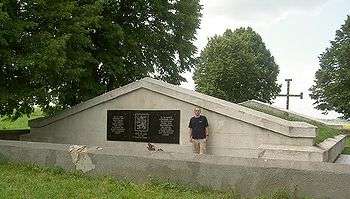Battle of Zborov (1917)
| Battle of Zborov | |||||||
|---|---|---|---|---|---|---|---|
| Part of Kerensky Offensive | |||||||
 Czechoslovak legionnaires in the trenches | |||||||
| |||||||
| Belligerents | |||||||
|
|
| ||||||
| Commanders and leaders | |||||||
|
|
| ||||||
| Strength | |||||||
| 3,530[1][2] | 5,500[3] | ||||||
| Casualties and losses | |||||||
|
167 killed, 17 fatally wounded, 11 missing ~700 injured |
3,300 soldiers (62 officers) captured, 20 guns and large amounts of military material seized | ||||||
The Battle of Zborov (Зборовское сражение in Russian, Schlacht bei Zborów in German, bitva u Zborova in Czech and Slovak) was a part of the Kerensky Offensive, (the last Russian offensive in World War I, taking place in July 1917). The battle was the first significant action of the Czechoslovak Legions (volunteers fighting against the Central Powers) on the Eastern Front and the only successful engagement of the failed Russian offensive in Ukraine.
Background
As the reliability of many Russian military formations was in doubt, only units that volunteered to attack were used in the offensive. Among those who did was the Czechoslovak Riflemen Brigade (Československá střelecká brigáda) formed from three regiments of Czechs and Slovaks. The brigade (about 3,530 men), was low on equipment and training. Moreover, this was the first use of the brigade as a single formation; previously, the Russian command had used only smaller units of the brigade, mostly in reconnaissance actions. On the other hand, overall morale amongst the members of the brigade was very high.[1]
The brigade was commanded by Russian colonel Vyacheslav Platonovich Trojanov, but the tactical assault plan was prepared by Czech and Slovak officers serving in the Czechoslovak Legion. Professor Thomas Masaryk, the main organizer of the Czechoslovak resistance against Austria-Hungary, was in telegraphic connection with colonel Nikolai Petrovich Mamontov so he could follow a situation from Petersburgh.
The brigade was deployed near Zborov, a town in today's Ukraine, in a sector of secondary importance. The 4th division protected it from the north, the 6th division from the south. The enemy, the army of Austria-Hungary, deployed four well entrenched and well equipped infantry regiments (IR), the IR 6, 35, 75 and 86 (in all, about 12,000 men).

Battle
At 5:15 on 2 July, the second day of the offensive, after an initial artillery bombardment, small groups of Legionnaires equipped with grenades attacked the enemy (see: Shock troops tactic). At 8:00 the colonel Mamontov rings by phone to lieutenant Stanislav Čeček to start attack. After they breached the barbed wire defenses, follow-up units continued with the attack. By 15:00 the Legion had advanced deep into enemy territory, breaking through the entire Austrian trench line. 3,300 enemy soldiers (62 officers) were captured; 20 guns and large amounts of war material were seized. The Czechoslovak losses were 167 killed, 17 mortally wounded, 11 missing and around 700 injured.
Aftermath
This success had no wider effect on the doomed offensive. The battle, however, gave propaganda and political capital to the leaders of the Czechoslovak resistance and convinced the Russian government to end its limitations on new units formed from Czech and Slovak soldiers captured during the war. Moreover, news of the armed action of the Czech exterior resistance reached the Czech people in Austria-Hungary for the first time. Any reference to Czech volunteers fighting on the side of the Entente was suppressed by censorship. But the surprising victory by the smaller Czechoslovak forces incited some Austrian politicians to demand an investigation of alleged treason by Czech units in the Austro-Hungarian Army and this made the victorious legionaries famous across the Empire.
After the war, the battle was used to propagate the heroic military cult surrounding the Legions who formed a cornerstone of the new Czechoslovak state. During the German occupation of Czechoslovakia (1939-1945), and later, when the communist party took power in 1948, the story was suppressed or ignored.
In the arts
The battle was depicted in a 1938 Czech language propaganda film Zborov. The movie was based on a story by Rudolf Medek and directed by Jiří Slavíček and Jan Alfréd Holman.
Due to the Munich Agreement, a shortened version of Zborov was first screened in January 1939.
References
- 1 2 "Bitva u Zborova" (in Czech). Bellum.cz. Retrieved 5 July 2016.
- ↑ "Zborov 1917" (in Czech). Zborov 1917-2012. Retrieved 5 July 2016.
- ↑ "Zborov 1917" (in Czech). Valka.cz. Retrieved 5 July 2016.
Sources
- Rudolf Medek, Vojtěch Holeček: "Bitva u Zborova a československý odboj" (Battle of Zborov and Czechoslovak resistance), 1922
- Jan Galandauer: "2.7.1917 Bitva u Zborova - Česká legenda" (June 2, 1917 Battle of Zborov - the Czech legend), 2002, ISBN 80-86515-16-8
External links
| Wikimedia Commons has media related to Battle of Zborov (1917). |